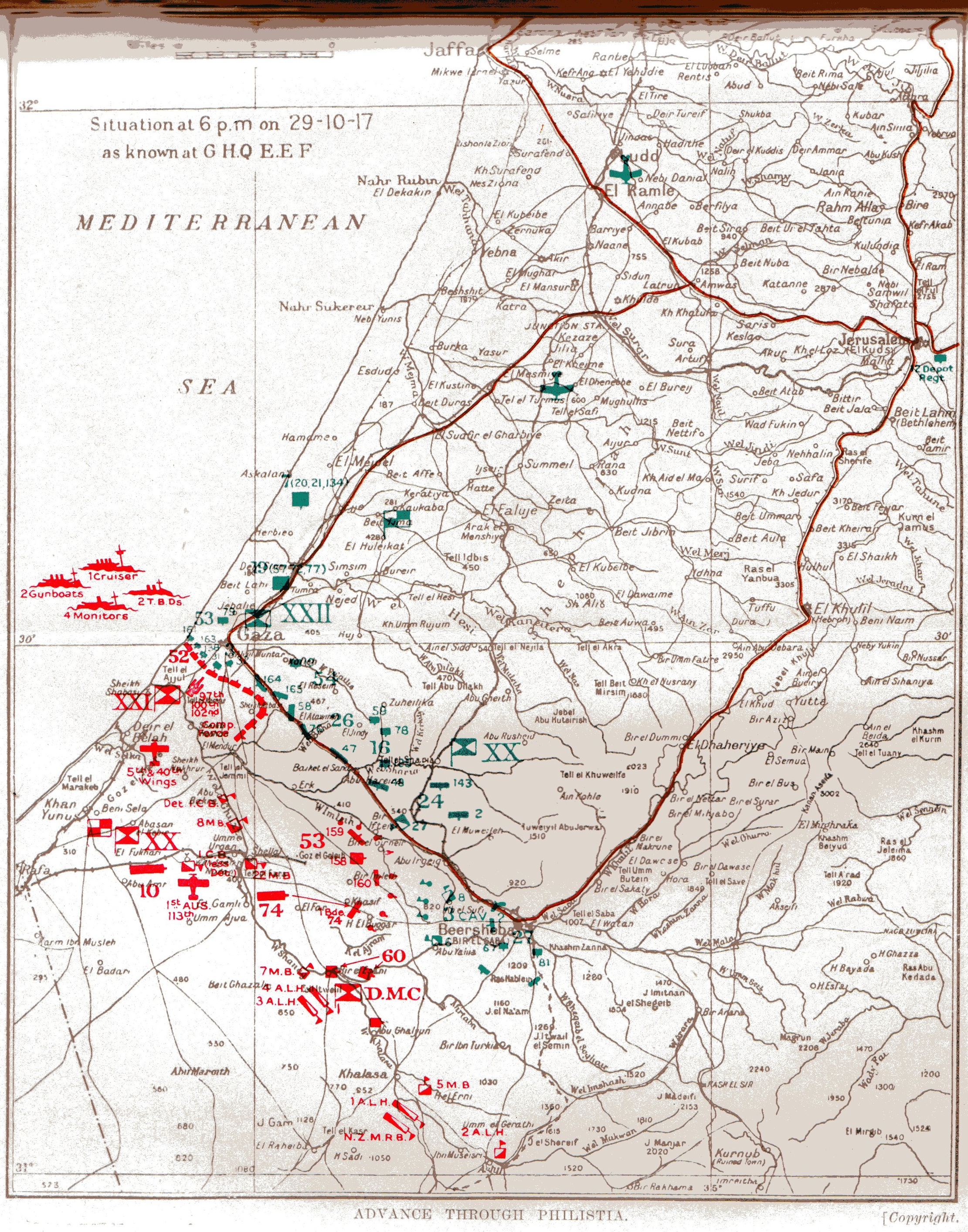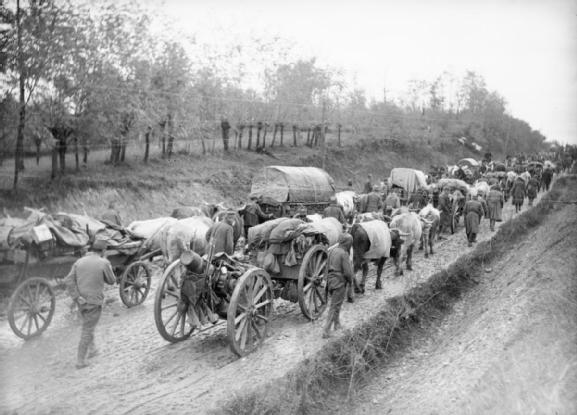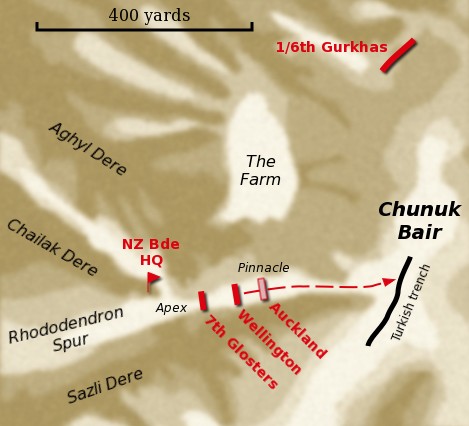|
British 29th Infantry Brigade
The 29th Infantry Brigade was an infantry brigade unit of the British Army. It was originally raised in 1914 and saw service during the First and Second World Wars and the Korean War. First World War The 29th Brigade was formed in August 1914 as part of the 10th (Irish) Division, of the first wave of Kitchener's Army (K1). The division and brigade transferred to Lemnos in July 1915 in preparation for the Gallipoli landings. The 29th Infantry Brigade landed at Anzac Cove on August 6/7 of the same year, participating in the Battle of Chunuk Bair. The 10th (Irish) Division was withdrawn from Gallipoli to Salonika at the end of September 1915, elements of the division participating in actions at Karajakois, Yenikoi and Kosturino. In early September 1917, the Division was withdrawn to Egypt and took part in the Palestine Campaign where it fought in the third Battle of Gaza. The division moved back to Cairo at the end of the war. Second World War In the Second World War, the Cairo B ... [...More Info...] [...Related Items...] OR: [Wikipedia] [Google] [Baidu] |
Infantry
Infantry is a military specialization which engages in ground combat on foot. Infantry generally consists of light infantry, mountain infantry, motorized infantry & mechanized infantry, airborne infantry, air assault infantry, and marine infantry. Although disused in modern times, heavy infantry also commonly made up the bulk of many historic armies. Infantry, cavalry, and artillery have traditionally made up the core of the combat arms professions of various armies, with the infantry almost always comprising the largest portion of these forces. Etymology and terminology In English, use of the term ''infantry'' began about the 1570s, describing soldiers who march and fight on foot. The word derives from Middle French ''infanterie'', from older Italian (also Spanish) ''infanteria'' (foot soldiers too inexperienced for cavalry), from Latin '' īnfāns'' (without speech, newborn, foolish), from which English also gets '' infant''. The individual-soldier term ''infantry ... [...More Info...] [...Related Items...] OR: [Wikipedia] [Google] [Baidu] |
Kitchener's Army
The New Army, often referred to as Kitchener's Army or, disparagingly, as Kitchener's Mob, was an (initially) all-volunteer portion of the British Army formed in the United Kingdom from 1914 onwards following the outbreak of hostilities in the First World War in late July 1914. It originated on the recommendation of Herbert Kitchener, then the Secretary of State for War to obtain 500,000 volunteers for the Army. Kitchener's original intention was that these men would be formed into units that would be ready to be put into action in mid-1916, but circumstances dictated the use of these troops before then. The first use in a major action of Kitchener's Army units came at the Battle of Loos (September–October 1915). Origins Contrary to the popular belief that the war would be over by Christmas 1914, Kitchener predicted a long and brutal war. He believed that arrival in Europe of an overwhelming force of new, well-trained and well-led divisions would prove a decisive blow agai ... [...More Info...] [...Related Items...] OR: [Wikipedia] [Google] [Baidu] |
Standing Army
A standing army is a permanent, often professional, army. It is composed of full-time soldiers who may be either career soldiers or conscripts. It differs from army reserves, who are enrolled for the long term, but activated only during wars or natural disasters, and temporary armies, which are raised from the civilian population only during a war or threat of war and disbanded once the war or threat is over. Standing armies tend to be better equipped, better trained, and better prepared for emergencies, defensive deterrence, and particularly, wars. Wills, Garry (1999). ''A Necessary Evil, A History of American Distrust of Government'' New York, N.Y.; Simon & Schuster. The term dates from approximately 1600 CE, although the phenomenon it describes is much older. History Ancient history Mesopotamia Sargon of Akkad, the founder of the Akkadian Empire, is believed to have formed the first standing professional army. Tiglath-Pileser III of Assyria (ruled 745–727 BC) created t ... [...More Info...] [...Related Items...] OR: [Wikipedia] [Google] [Baidu] |
The British Army In The United Kingdom 1939-1945 H11185
''The'' () is a grammatical article in English, denoting persons or things already mentioned, under discussion, implied or otherwise presumed familiar to listeners, readers, or speakers. It is the definite article in English. ''The'' is the most frequently used word in the English language; studies and analyses of texts have found it to account for seven percent of all printed English-language words. It is derived from gendered articles in Old English which combined in Middle English and now has a single form used with pronouns of any gender. The word can be used with both singular and plural nouns, and with a noun that starts with any letter. This is different from many other languages, which have different forms of the definite article for different genders or numbers. Pronunciation In most dialects, "the" is pronounced as (with the voiced dental fricative followed by a schwa) when followed by a consonant sound, and as (homophone of pronoun ''thee'') when followed by a v ... [...More Info...] [...Related Items...] OR: [Wikipedia] [Google] [Baidu] |
Cairo
Cairo ( ; ar, القاهرة, al-Qāhirah, ) is the capital of Egypt and its largest city, home to 10 million people. It is also part of the largest urban agglomeration in Africa, the Arab world and the Middle East: The Greater Cairo metropolitan area, with a population of 21.9 million, is the 12th-largest in the world by population. Cairo is associated with ancient Egypt, as the Giza pyramid complex and the ancient cities of Memphis and Heliopolis are located in its geographical area. Located near the Nile Delta, the city first developed as Fustat, a settlement founded after the Muslim conquest of Egypt in 640 next to an existing ancient Roman fortress, Babylon. Under the Fatimid dynasty a new city, ''al-Qāhirah'', was founded nearby in 969. It later superseded Fustat as the main urban centre during the Ayyubid and Mamluk periods (12th–16th centuries). Cairo has long been a centre of the region's political and cultural life, and is titled "the city of a thousand m ... [...More Info...] [...Related Items...] OR: [Wikipedia] [Google] [Baidu] |
Third Battle Of Gaza
The Third Battle of Gaza was fought on the night of 1–2 November 1917 between British and Ottoman forces during the Sinai and Palestine Campaign of World War I and came after the British Egyptian Expeditionary Force (EEF) victory at the Battle of Beersheba had ended the Stalemate in Southern Palestine. The fighting occurred at the beginning of the Southern Palestine Offensive, and, together with attacks on Hareira and Sheria on 6–7 November and the continuing Battle of Tel el Khuweilfe, which had been launched by General Edmund Allenby on 1 November, it eventually broke the Gaza-to-Beersheba line defended by the Yildirim Army Group. Despite having held this line since March 1917, the Ottoman Army was forced to evacuate Gaza and Tel el Khuweilfe during the night of 6–7 November. Only Sheria held out for most of the 7 November before it too was captured.The several battles fought for the Gaza to Beersheba line between 31 October and 7 November were all assigned the t ... [...More Info...] [...Related Items...] OR: [Wikipedia] [Google] [Baidu] |
Egypt
Egypt ( ar, مصر , ), officially the Arab Republic of Egypt, is a transcontinental country spanning the northeast corner of Africa and southwest corner of Asia via a land bridge formed by the Sinai Peninsula. It is bordered by the Mediterranean Sea to the north, the Gaza Strip of Palestine and Israel to the northeast, the Red Sea to the east, Sudan to the south, and Libya to the west. The Gulf of Aqaba in the northeast separates Egypt from Jordan and Saudi Arabia. Cairo is the capital and largest city of Egypt, while Alexandria, the second-largest city, is an important industrial and tourist hub at the Mediterranean coast. At approximately 100 million inhabitants, Egypt is the 14th-most populated country in the world. Egypt has one of the longest histories of any country, tracing its heritage along the Nile Delta back to the 6th–4th millennia BCE. Considered a cradle of civilisation, Ancient Egypt saw some of the earliest developments of writing, agriculture, ur ... [...More Info...] [...Related Items...] OR: [Wikipedia] [Google] [Baidu] |
Battle Of Kosturino
The Battle of Kosturino was a World War I battle, fought between 6 and 12 December 1915. The battle was fought in the initial stage of the Macedonian campaign, in the Balkans Theatre. On 6 December, a Bulgarian troops attacked the French and British-held trenches in Kosturino, at the time part of the Kingdom of Serbia (present day North Macedonia). The offensive was at first held in check, however on 8 December, Bulgaria managed to infiltrate the Memesli ravine. Bulgaria then seized Crete Simonet, thus threatening to outflank the Allies. The Entente defeat at Kosturino led to the complete withdrawal of Allied forces from Serbia, thus enabling the Central Powers to build the Berlin to Constantinople rail line. The Allies in the meantime concentrated on solidifying their defenses in Greece. Prelude The 28 June 1914, assassination of Austro-Hungarian heir presumptive Archduke Franz Ferdinand precipitated Austria-Hungary's declaration of war against Serbia. The conflict quickly a ... [...More Info...] [...Related Items...] OR: [Wikipedia] [Google] [Baidu] |
Yenikoi
Provatas (Greek: Προβατάς) is a larger village in Kapetan Mitrousi, Serres regional unit, northern Greece. It has 1,099 inhabitants (2011 census). Until 1923, the village was called ''Yenikoi'' or ''Yeniköy'' and inhabited mostly by Turks and Bulgarians. It was hard fought over on October 3 and 4, 1916, between the 10th (Irish) Division The 10th (Irish) Division, was one of the first of Kitchener's New Army K1 Army Group divisions (formed from Kitchener's 'first hundred thousand' new volunteers), authorized on 21 August 1914, after the outbreak of the Great War. It included b ... and the Bulgarian Army. The Irish took and held the village, despite fierce and costly counterattacks by the Bulgarians. The Salonika Campaign. ''Dublin Fusiliers.com''. Retrieved 26 February ... [...More Info...] [...Related Items...] OR: [Wikipedia] [Google] [Baidu] |
Karajakois
Monokklisia () is a village in Kapetan Mitrousi, Serres regional unit, northern Greece Greece,, or , romanized: ', officially the Hellenic Republic, is a country in Southeast Europe. It is situated on the southern tip of the Balkans, and is located at the crossroads of Europe, Asia, and Africa. Greece shares land borders with .... In Monokklisia gender equality has been achieved due to the special ancient custom of gynecocracy (γυναικοκρατία), that takes place every year on January 8. References {{coord, 41, 04, N, 23, 24, E, region:GR_type:city_source:enwiki-GNS, display=title Populated places in Serres (regional unit) ... [...More Info...] [...Related Items...] OR: [Wikipedia] [Google] [Baidu] |
Salonika
Thessaloniki (; el, Θεσσαλονίκη, , also known as Thessalonica (), Saloniki, or Salonica (), is the second-largest city in Greece, with over one million inhabitants in its metropolitan area, and the capital of the geographic region of Macedonia, the administrative region of Central Macedonia and the Decentralized Administration of Macedonia and Thrace. It is also known in Greek as (), literally "the co-capital", a reference to its historical status as the () or "co-reigning" city of the Byzantine Empire alongside Constantinople. Thessaloniki is located on the Thermaic Gulf, at the northwest corner of the Aegean Sea. It is bounded on the west by the delta of the Axios. The municipality of Thessaloniki, the historical center, had a population of 317,778 in 2021, while the Thessaloniki metropolitan area had 1,091,424 inhabitants in 2021. It is Greece's second major economic, industrial, commercial and political centre, and a major transportation hub for Greece and south ... [...More Info...] [...Related Items...] OR: [Wikipedia] [Google] [Baidu] |
Battle Of Chunuk Bair
The Battle of Chunuk Bair ( tr, Conk Bayırı Muharebesi) was a World War I battle fought between the Ottoman defenders and troops of the British Empire over control of the peak in August 1915. The capture of Chunuk Bair, ( tr, Çanak Bayır Basin Slope, now ''Conk Bayırı''), the secondary peak of the Sari Bair range, was one of the two objectives of the Battle of Sari Bair. British units that reached the summit of Chunuk Bair early on 8 August 1915 to engage the Turks were the Wellington Battalion of the New Zealand and Australian Division, 7th (Service) Battalion, Gloucestershire Regiment; and 8th (Service) Battalion, Welch Regiment, both of the 13th (Western) Division. The troops were reinforced in the afternoon by two squads of the Auckland Mounted Rifles Regiment, also part of the New Zealand and Australian Division. The first troops on the summit were severely depleted by Ottoman return fire and were relieved at 10:30pm on 8 August by the Otago Battalion (NZ), and the ... [...More Info...] [...Related Items...] OR: [Wikipedia] [Google] [Baidu] |



.png)



